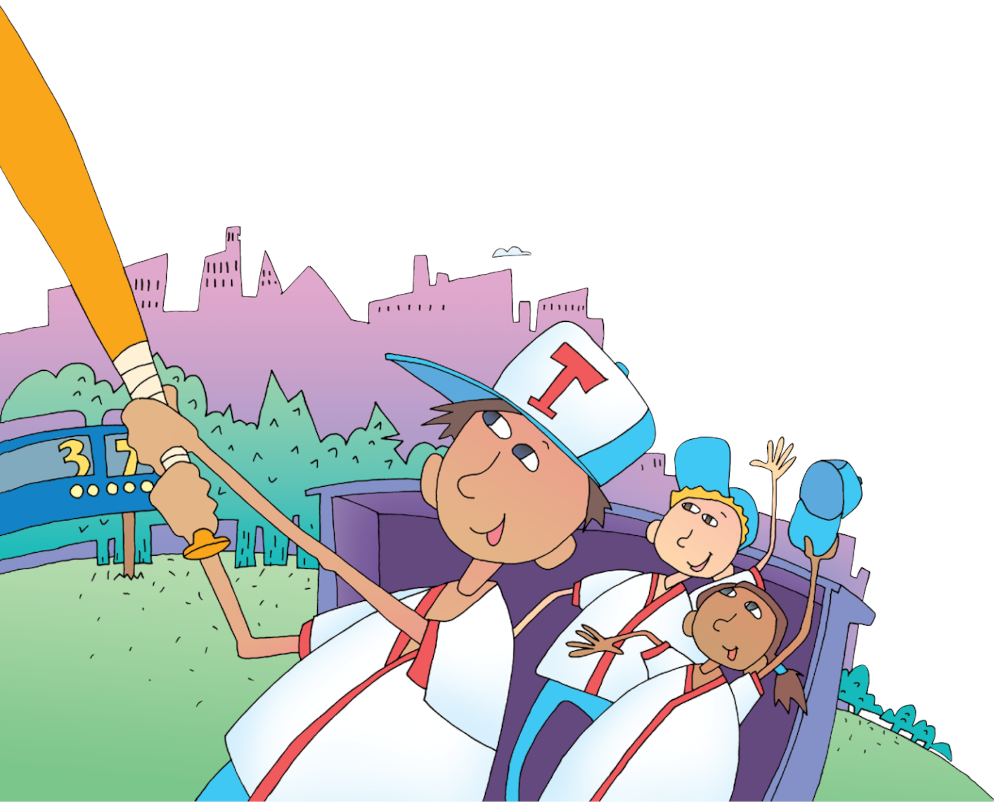WT 094
Page 94
Writing Realistic Stories
A realistic story could have happened, but it is made up. The details and characters come from real life, but the story itself never actually occurred (it is fictional). Sometimes these stories are called realistic fiction.
As you read the story on the next page, think of real experiences you have had and ways that you could spin them together into a realistic story.
WT 095
Page 95
Sample Realistic Story
Josh’s story centers on a time when he was at bat in a baseball game. In the story, he is called Rob and is under great pressure. How does he handle it? Which parts of this story do you think really happened to Josh?
A Dream Hit
Setting the scene The score was tied 8 to 8 in the bottom of the ninth, with bases loaded and two outs. If Rob could just get a hit, the Terriers would win.
Stating the problem But he’d never gotten a hit in his life.
Building tension He stepped up to the plate, tapped the bat on the sole of his shoe, and lifted it. Here came the pitch. Rob couldn’t even see the ball.
“Stee-rike 1!” crowed the ump.
Rob took a deep breath as the catcher threw the ball back. The pitcher wound up. . . .
“Stee-rike 2!”
“At least swing!” shouted Coach.
The next pitch cut white-hot toward Rob. He swung. CRACK! The ball rocketed over the outfield fence and kept going. It soared above a passing airplane. Still it went, ripping free of earth’s gravity. It punched through a comet and finally smashed into the moon, making a huge crater.
“You did it!” Coach shouted. “You won!”
Reaching a climax “I got a hit! I drove in a run!” Rob cried out, amazed. But he wasn’t running bases. He was lying on his back, a goose-egg growing on his temple.
Ending with a surprise “You got hit, all right,” Coach said. “You okay?”
“You bet, Coach,” Rob replied. “It was a dream hit.” And then, sure enough, he was dreaming.

WT 096
Page 96
Writing a Realistic Story
Prewriting
Choose a Topic 🟪 To come up with a good idea for your story, follow these steps:
- Write down at least three exciting, funny, or odd events from your life.
- Choose one event to use as the starting point for your story.
Test the Event 🟪 Your story idea will work if you can answer yes to these questions:
- Do I remember many details about this event?
- Will my classmates like to read about it?
- Can I keep this story realistic but alter it to make it fictional?
Tip
Your story should have a problem that needs to be solved. In the sample story, Rob was afraid he was going to strike out. (You can fictionalize a real event using this strategy.)
- Do I remember many details about this event?
- Will my classmates like to read about it?
- Can I keep this story realistic but alter it to make it fictional?
Tip
Your story should have a problem that needs to be solved. In the sample story, Rob was afraid he was going to strike out. (You can fictionalize a real event using this strategy.)
WT 097
Page 97
Writing a Draft
Start Strong 🟪 Write the event as it actually occurred. Have the characters face a problem in a specific place and time.
Use Your Imagination 🟪 Turn the real event into a made-up story.
- Change the names of the characters.
- Change where the action takes place.
- Change how the event begins or ends.
- Add more details to the story.